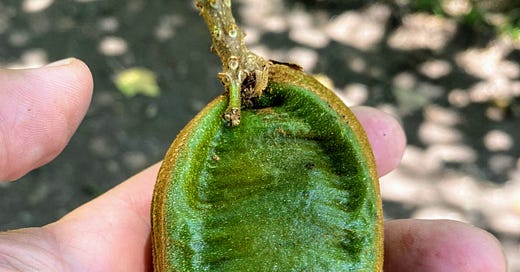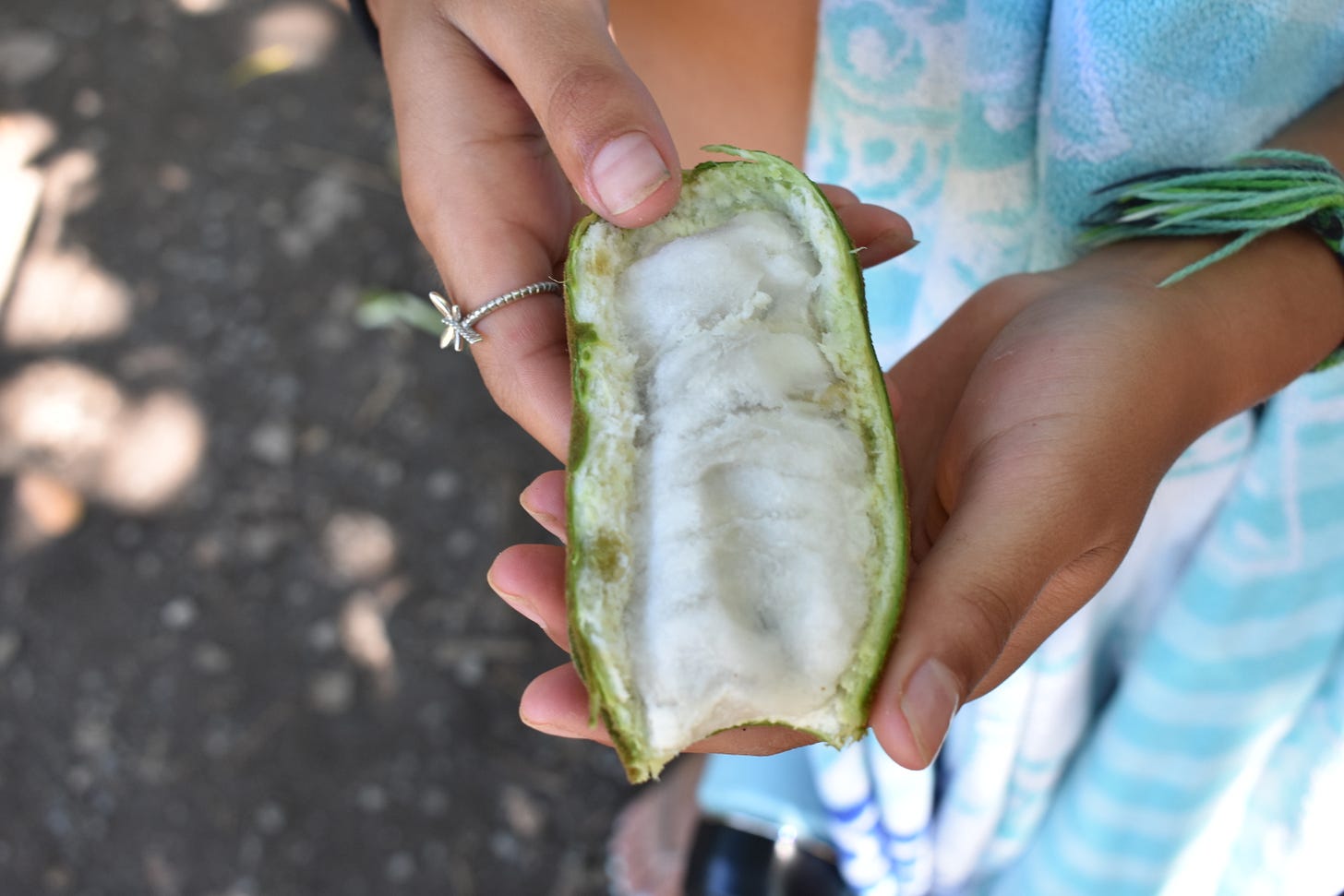This journey all started with my daughter’s infatuation with ice cream bean. While visiting Hawaii with her mother several years ago, the two of them had been given a tip and stopped by the side of the road to pick some pods from the leguminous tree known elsewhere as Inga.
Now my daughter was no newbie to foraging. By the age of 3 or 4 she had experienced half of the edible plants of the Sonoran desert and has since been exposed to more wild edibles than the vast majority of adults in this country. But ice cream bean became the stuff of legends.
So as our new family of 5 was headed to Maui for the first time, we had one foraging goal: find ice cream bean!
Inga edulis is a native of Central & South America where it often fills in along the margins and in disturbed areas. As a bean family (Fabaceae) member it is known to fix nitrogen in the soil via symbiotic relationships with bacteria and fungi in the soil. Thus, it’s been implemented as a pioneer species in agroforestry operations in Central America where it can lead with shade for the future forest crops while preparing the soil for the forest to come.
I’m not sure how long it’s been in the Hawaiian islands, but several legume trees were introduced by the Spanish and Portuguese during the whaling era as Hawaii’s native trees were decimated and they need fast-growing, hot-burning wood as a local resource for processing whale oil. I’m not sure how ice cream bean, or Inga, figured in that scenario.
But we were intent on tasting this ice cream-esque bean with reported vanilla flavoring. It’s not the bean we’re looking to eat, but similar to its distant cousin mesquite, we’re looking to eat the endocarp, or the portion of the pod that surrounds bean. However, in the case of mesquite (Prosopis species), one also eats the mesocarp, or all that surrounds the seed and comprises the pod itself.
The endocarp, or pulp, that surrounds the individual dark colored seeds is light, like cotton candy, but moist. These fat, elongated green pods develop a golden fuzz as they mature and appear from Mimosa-like flowers that appear around the upper surface of the tree facing up towards the sun. I couldn’t get any good photos of the flowers as it was midday and mature trees were the only ones currently flowering with all the flowers up in the canopy 15-25 feet above ground.
Details of the compound leaves are a very distinguishing feature. If you look at the space in between the leaflets (along the rachis, or thin stem from which the leaflets emerge), you can see some extra leaf coming out.
But the good news was we had found a stand of ice cream bean! So next we had to figure out how to gather some pods, all of which were at least 10 feet off the ground, some of them double that. First we tried climbing the tree - well, the smallest of us did. Then I went into survival mode scanning my environment for material I can turn into a tool to feed my family. Now it was a matter of life and death.
Through the brush I spotted a stand of thin, clumping bamboo. I pulled out my knife and grabbed a long, thin shoot and cut it back close to the ground. Next, how to use it? I first cut a “V” notch at the thinner end to try to push or pry a pod off. No such luck. They are gripped tight. Next I thought of making something like a kuiput, the traditional saguaro harvesting tool made from saguaro ribs that is designed to either push or pull the ripened fruit from atop the tall cacti of the Sonoran desert. But bamboo flexes as do the branches from which the pods hang - not at all like the firm stance of the arms of a saguaro and its stationary fruit. I needed another idea…
Rigth! Bamboo has tensile strength. You can split it partially and it will run no further than the culm just above, and it splits clean. So I quickly made a diagonal cut into a sufficiently thick section to make something like a retorsed hook so that I could grasp the pod by its stem and pull it down or yank it off downward. Vóila! We had our first ice cream bean to taste.
Well the first tree was disappointing. The flavor was diminished, but we weren’t too surprised as these pods were longer and we had learned from some research that the shorter pods were much tastier. On to the next tree!
Indeed these pods were much shorter, fat, and green to slightly golden. I think we’ve come to the right tree. So, how did it taste…?
I shot some video of the girls opening and tasting the pods, but, unfortunately, I can’t share that here. But they loved it! Frankly, I’m more of a fan of less sweet or at least sweet and sour fruit (I was excited to find fresh from the tree papaya - they find it disgusting).
I could try growing ice cream bean here in the Sonoran desert, but it is very susceptible to frost - although it could handle the heat and drought, I believe. it certainly looks more like a humid forest tree to me, and that’s where we found it on the island. A great deal of the island is exceptionally dry and pales in comparison to the summer moisture we get here in the Sonoran desert, but without the ocean breezes we lose most of that moisture quickly (that which doesn’t get captured by the drought-tolerant plants, or held within the ground below substantial mulch).
Have any Inga stories? Please share them in the comments below.







